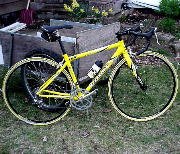Acer rubrum, the Red Maple, flowers high in the canopy (and for convenience about 8ft away outside one of my upper windows). Sweetly fragrant, and a spring fragrance which was a mystery to me for years until I was lucky enough to find a branch down at nose level (that branch since removed, since it was also at eye level!). The close-up is from back then, 26 April 2000. Anthers are open on most of the flowers in the first photo, but not yet open in the close-up, hence the lack of yellow. However there is some natural variation in the colour of the flower from one tree to the next. Sugar maple,
Acer saccharum, blooms somewhat later, with smaller less showy yellow-green flowers-- and no scent that I've located yet.


Some other Spring things:
 Chionodoxa sardensis
Chionodoxa sardensis, Glory of the Snow, the brightest blue I've seen in a flower except for a few gentians. A different species of this is more commonly grown, has larger flowers but not as blue. Every spring I am amazed that this little thing is still alive (and increasing!) since it is in an area replete with weeds.
 Hepatica nobilis
Hepatica nobilis. Used to be a clump with dozens of flowers but the darn deer are fond of it and browse it to the ground, usually when in full flower. So it loses a lot of energy each year regrowing a few leaves to replace those that went into the deer salad.
Not finished with the Hellebores yet:

A double form of
Helleborus orientalis hybrid, grown from seed obtained from I don't know where anymore, it has taken a few years to see the first flowers on some of the plants; it looks like about half will be doubles but the others aren't yet in a state useful to photograph yet.

Another hybrid, this one showing that the cold snap caused damage to the flower despite it being in a tight bud still at that point-- the anthers are all dead (the little cone of brown things in the middle)

And here, Helleborus niger, the Christmas Rose, already pollinated so the sepals are turning from white to a pinkish shade of tan (on other plants they go to green or something between or ...). There is something in the leaf litter that likes to eat the sepals of this species, but it leaves the orientalis and hybrids alone. Might be just because the flowers of niger are so low and touching the litter whereas the others have longer stems and are above all that.
And one final spring thing for today, a few colour forms from seed, of
Corydalis solida, a small but showy spring ephemeral that grows from a bulb and is quite adaptable as far as sun and shade are concerned.



 a selection of Rhododendron dauricum forma alba. Always the first Rhodo to flower here. Planted in 1990 as a 2 in or 5 cm tissue culture sprig, it is now about 6 ft or 2 m high and wide. Usually flowers around the beginning of May. And a close-up of the flower.
a selection of Rhododendron dauricum forma alba. Always the first Rhodo to flower here. Planted in 1990 as a 2 in or 5 cm tissue culture sprig, it is now about 6 ft or 2 m high and wide. Usually flowers around the beginning of May. And a close-up of the flower.
 until the first week of May. Smaller than the above, but the same age. She has two sisters around here, a larger-flowered "April Mist" with lavender blooms, and a double white "April Gem".
until the first week of May. Smaller than the above, but the same age. She has two sisters around here, a larger-flowered "April Mist" with lavender blooms, and a double white "April Gem".










































